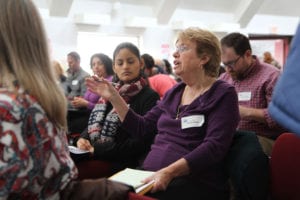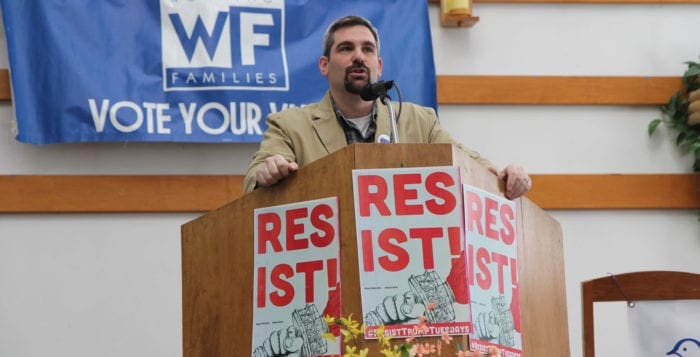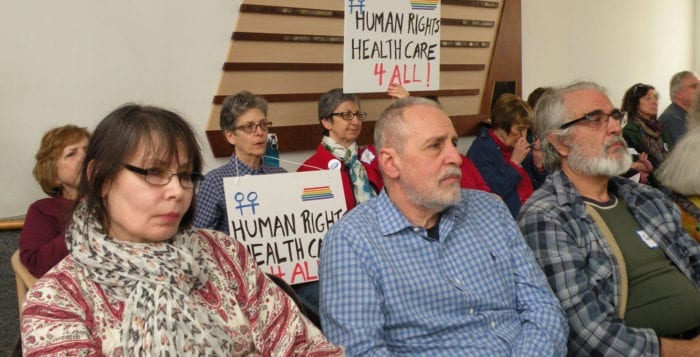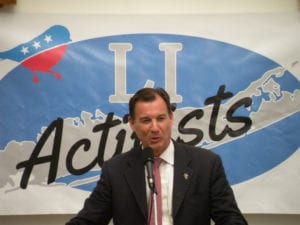By Victoria Espinoza
Activism is on the rise in the aftermath of the 2016 election on the North Shore and beyond, though at an event in Huntington concerned citizens signed up to do more than carry signs and initiate chants.
On Saturday, March 11, more than 100 people gathered at Unitarian Universalist Fellowship of Huntington to participate in a training program to run for office hosted by the Working Families Party, along with Long Island Activists, the New York State United Teachers and the Long Island Progressive Coalition.
Ron Widelec, a member of the Long Island Activists, said he believes activism and running for office should go hand in hand.
“These are not separate things, they actually have to work together,” he said. Recently the groups have banded together to support issues like a new health care law for New York, and Widelec said that’s an issue in particular dependent on having the ear of politicians. For a health care rally he played a part in organizing this month, he said he invited his local state Sen. Carl Marcellino (R-Syosset) to the event, but Marcellino instead sent an aide in his place.
“As I was speaking, I looked [the aide] dead in the eye and said, ‘Our state senators need to know that they’re going to vote for this bill, or they’re not going to be our state senators very much longer,’” he said. “That threat only works if when in 2018 he’s up for re-election we can actually run a candidate, mount a campaign and flip that seat. So these things have to work together.”

At the event residents learned how to run a successful campaign including conducting fundraisers, getting out the vote and more.
“The concept behind trainings like this is to start running an army of activists citizens who are running for office, not because they’ve been waiting in line for 20 years and finally the local party meets in their little smoke-filled rooms and decides so and so is going to be the candidate,” Widelec said. “The idea is that we get regular people who identify with the struggles of ordinary people and working families … nurses, teachers, small business owners.”
Town officials also came to encourage a new generation of politicians.
Brookhaven Town Councilwoman Valerie Cartright (D-Port Jefferson Station) said she came up through the same channels as attendees of the training program.
“I am excited to be here today and even more excited to look around this room at the people who are here to get more information and be more engaged,” she said at the event.
Cartright said she was asked to run for office in 2013 and said “no” twice before reconsidering.
“I never thought of running for office because all I knew of politics was what I saw on television which was negative and corrupt,” she said. However she realized she could help more people while holding public office and is happy she ultimately said “yes,” adding, “People in this room, you’re already starting to say ‘yes’ by being here — and that’s important.”
Cartright said she understands some people may be sharing the same hesitation she once had, but she encouraged them to push through.
“I understand for many of you the reason for being here is what’s going on the national level,” she said. “But let’s not forget that all politics are local. If you don’t want to be political or never thought of yourself as a political person, like I used to think, put that to the back burner … because as much as you might not think so everything is political. Even when you decide which family members to invite to Thanksgiving — that’s political.”
Jeff Friedman, Long Island political organizer for the NYSUT, voiced concerns for the nation’s state of education under the administration of President Donald Trump (R).

“In recent months and with political characters like Betsy DeVos … they really threaten to undermine public education as we know it,” he said.
He said every issue can be traced back to the need for effective elected officials.
Centerport resident Marge Acosta ran for a seat on the Harborfields school board in 2016, but was defeated. She said she attended the event because important issues are being debated on multiple levels of government right now.
“It was very motivating,” Acosta said of the event. ‘They gave a lot of really good advice. Everyone learned a lot about getting involved early enough, spreading the word and raising money.”
She said she was disheartened to realize how large of a role money plays in running a successful campaign.
“It’s a shame how much time people have to spend in fundraising,” she said. “One woman there said it was a big part of why she lost her campaign and it shouldn’t be that way. There are loads of highly qualified people who shouldn’t have to worry about raising huge sums of money.”
While Acosta said she’s not sure if she’s interested in running for office again, the event was still invaluable to her.
“Never say never,” she said. “But I think I could help bring this information to a lot of people who are ready to run for public office.”







